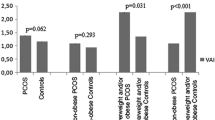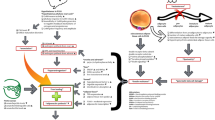Abstract
Purpose
This study aimed to investigate the interactive effect of polycystic ovary syndrome (PCOS) status and obesity status on the serum levels of adipokines.
Methods
In this comparative case–control cross-sectional study, 58 women with PCOS and 104 eumenorrheic non-hirsute women as the control group were recruited. They were further divided into two subgroups of overweight/obese and normal weight. The interactive effect of the PCOS status and obesity status on the circulating levels of adipokines was assessed using general linear model with the adjustment of age.
Results
A statistically significant negative interaction was reported between obesity status and PCOS status in the determination of serum adiponectin and resistin concentrations (effect size = −0.14, interaction P = 0.001, effect size = −0.15, P = 0.016). It indicated that adiponectin and resistin were significantly decreased in overweight/obese patients with PCOS compared with other subgroups. Statistically significant positive interactive effects were found between PCOS status obesity status and leptin (effect size = 0.321, interaction P = 0.036), indicating that the overweight/obese women with PCOS had the higher levels of leptin compared with the control group. Also, no interaction was reported between PCOS status and obesity status with regard to the serum levels of other adipokines.
Conclusions
While no sufficient evidence is available with regard to the causal association between adipokines and PCOS, they may contribute to the development of PCOS and regarded as the novel biomarkers of PCOS.
Similar content being viewed by others
References
Behboudi-Gandevani S, Ramezani Tehrani F, Rostami Dovom M, Farahmand M, Bahri Khomami M, Noroozzadeh M et al (2016) Insulin resistance in obesity and polycystic ovary syndrome: systematic review and meta-analysis of observational studies. Gynecol Endocrinol 32:343–353
Tehrani FR, Simbar M, Tohidi M, Hosseinpanah F, Azizi F (2011) The prevalence of polycystic ovary syndrome in a community sample of Iranian population: Iranian PCOS prevalence study. Reprod Biol Endocrinol 9:39
Lim SS, Davies MJ, Norman RJ, Moran LJ (2012) Overweight, obesity and central obesity in women with polycystic ovary syndrome: a systematic review and meta-analysis. Hum Reprod Update 18:618–637
Çakıroğlu Y, Vural F, Vural B (2016) The inflammatory markers in polycystic ovary syndrome: association with obesity and IVF outcomes. J Endocrinol Invest 39:899–907
Durmus U, Duran C, Ecirli S.(2016) Visceral adiposity index levels in overweight and/or obese, and non-obese patients with polycystic ovary syndrome and its relationship with metabolic and inflammatory parameters. J Endocrinol Invest 12:1–11
Groth SW (2010) Adiponectin and polycystic ovary syndrome. Biol Res Nurs 12:62–72
Rolland YM, Haren MT, Patrick P, Banks WA, Malmstrom TK, Miller DK, Morley JE (2007) Adiponectin levels in obese and non-obese middle-aged African-American women. Obes Res Clin Pract 1:1–78
Unger RH (2000) Leptin physiology: a second look. Regul Pept 92:87–95
Mendonca H, Montenegro Junior R, Foss M, Silva de Sá M, Ferriani R (2004) Positive correlation of serum leptin with estradiol levels in patients with polycystic ovary syndrome. Braz J Med Biol Res 37:729–736
Huang R, Yue J, Sun Y, Zheng J, Tao T, Li S et al (2015) Increased serum chemerin concentrations in patients with polycystic ovary syndrome: Relationship between insulin resistance and ovarian volume. Clin Chim Acta 450:6–369
Dogru T, Sonmez A, Tasci I, Bozoglu E, Yilmaz MI, Genc H et al (2007) Plasma visfatin levels in patients with newly diagnosed and untreated type 2 diabetes mellitus and impaired glucose tolerance. Diabetes Res Clin Pract 76:24–29
Yang R-Z, Lee M-J, Hu H, Pray J, Wu H-B, Hansen BC et al (2006) Identification of omentin as a novel depot-specific adipokine in human adipose tissue: possible role in modulating insulin action. Am J Physiol Endocrinol Metab 290:E1253- 61
Miyamoto Y, Morisaki H, Kokubo Y, Yamanaka I, Tomoike H, Okayama A, Yoshimasa Y, Morisaki T (2009) Resistin gene variations are associated with the metabolic syndrome in Japanese men. Obes Res Clin Pract 3:I–II
Polak K, Czyzyk A, Simoncinin T, Meczekalski B. New markers of insulin resistance in polycystic ovary syndrome. J Endocrinol Invest 2017; 40:1–8
Toulis KA, Goulis DG, Farmakiotis D, Georgopoulos NA, Katsikis I, Tarlatzis BC et al (2009) Adiponectin levels in women with polycystic ovary syndrome: a systematic review and a meta-analysis. Hum Reprod Update 15:297–307
Drolet R, Bélanger C, Fortier M, Huot C, Mailloux J, Légaré D et al (2009) Fat depot-specific impact of visceral obesity on adipocyte adiponectin release in women. Obesity 17:424–430
Xita N, Georgiou I, Chatzikyriakidou A, Vounatsou M, Papassotiriou G-P, Papassotiriou I et al (2005) Effect of adiponectin gene polymorphisms on circulating adiponectin and insulin resistance indexes in women with polycystic ovary syndrome. Clin Chem 51:416–423
Veldhuis JD, Pincus SM, Garcia-Rudaz MC, Ropelato MG, Escobar ME, Barontini M (2001) Disruption of the synchronous secretion of leptin, LH, and ovarian androgens in nonobese adolescents with the polycystic ovarian syndrome. J Clin Endocrinol Metab 86:3772–3778
Telli MH, Yildirim M, Noyan V (2002) Serum leptin levels in patients with polycystic ovary syndrome. Fertil Steril 77:932–935
Guvenc Y, Var A, Goker A, Kemal Kuscu N (2016) Assessment of serum chemerin, vaspin and omentin-1 levels in patients with polycystic ovary syndrome. J Int Med Res 44:796–805
Kort DH, Kostolias A, Sullivan C, Lobo RA (2015) Chemerin as a marker of body fat and insulin resistance in women with polycystic ovary syndrome. Gynecol Endocrinol 31:152–155
Tan BK, Chen J, Digby JE, Keay SD, Kennedy CR, Randeva HS (2006) Increased visfatin mRNA and protein levels in adipose tissue and adipocytes in women with polycystic ovary syndrome (PCOS): parallel increase in plasma visfatin. J Clin Endocrinol Metab 91:5022–5028
Lajunen TK, Purhonen AK, Haapea M, Ruokonen A, Puukka K, Hartikainen AL et al (2012) Full-length visfatin levels are associated with inflammation in women with polycystic ovary syndrome. Eur J Clin Invest 42:321–328
Kazama K, Usui T, Okada M, Hara Y, Yamawaki H (2012) Omentin plays an anti-inflammatory role through inhibition of TNF-α-induced superoxide production in vascular smooth muscle cells. Eur J Pharmacol 686:116–123
Yang H-Y, Ma Y, Lu X-H, Liang X-H, Suo Y-J, Huang Z-X, et al. (2015) The correlation of plasma omentin-1 with insulin resistance in non-obese polycystic ovary syndrome. Ann Endocrinol 76:620–627
Panidis D, Koliakos G, Kourtis A, Farmakiotis D, Mouslech T, Rousso D (2004) Serum resistin leve in women with polycystic ovary syndrome. Fertil Steril 81:361–366
Acknowledgements
This study was financially supported by Reproductive Endocrinology Research Center, Research Institute for Endocrine Sciences affiliated with Shahid Beheshti University of Medical Sciences, Tehran, Iran.
Author information
Authors and Affiliations
Corresponding author
Ethics declarations
Conflict of interest
This study was supported by a research grant of Reproductive Endocrine Research Center, research institute for Endocrine Sciences, Shahid Beheshti University of Medical Sciences.
Ethical approval
All procedures followed were in accordance with the ethical standards of the responsible committee on human experimentation (institutional and national) and with the Helsinki Declaration of 1975, as revised in 2008.
Informed consent
Informed consent was obtained from all patients for being included in the study.
Rights and permissions
About this article
Cite this article
Behboudi-Gandevani, S., Ramezani Tehrani, F., Bidhendi Yarandi, R. et al. The association between polycystic ovary syndrome, obesity, and the serum concentration of adipokines. J Endocrinol Invest 40, 859–866 (2017). https://doi.org/10.1007/s40618-017-0650-x
Received:
Accepted:
Published:
Issue Date:
DOI: https://doi.org/10.1007/s40618-017-0650-x




